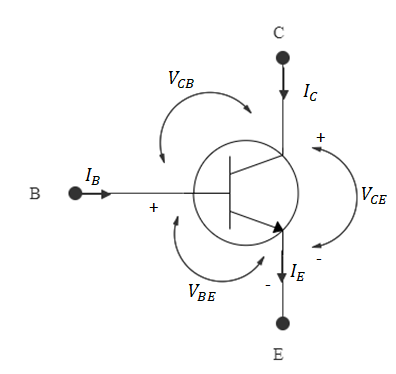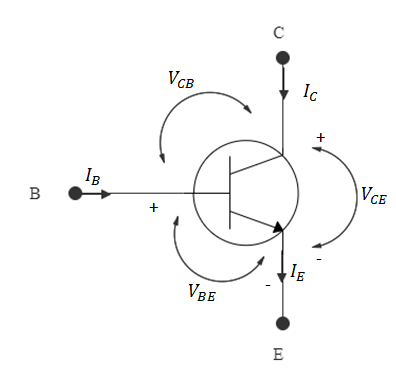
If collector current is 120mA and base current is 2mA and resistance gain is 3, what is power gain?
A. 180
B. 10800
C. 1.8
D. 18
Answer
581.4k+ views
Hint: Knowledge of transistors is necessary to solve this problem. NPN or PNP kind of transistor will not matter in this problem. The ratio of collector output current to the input base current is known as the DC current gain $ (\beta ) $ is necessary, $ \beta =\dfrac{{{I}_{C}}}{{{I}_{B}}} $ . The power gain = Resistance gain ( $ {{R}_{gain}} $ ) times DC current gain $ (\beta ) $ squared. That is Power gain $ ={{R}_{gain}}\times {{(\beta )}^{2}} $ .
Complete step-by-step answer:
Before we start solving this problem, let’s first find out the basics of a transistor using a NPN transistor as an example. Below is the circuit symbol of a conventional bipolar NPN transistor.

B is known as the Base of the transistor and C is the Collector, while E refers to the Emitter. The voltage between the Base and the Emitter is known as $ {{V}_{BE}}, $ this value will be positive towards the Base and negative towards the Emitter for this case. The Base terminal will always be positive with respect to the terminal for a NPN transistor. Similarly, the voltage between the Collector and Emitter known as $ {{V}_{CE}}, $ is positive towards the Collector end and negative towards the Emitter end. Hence, the supply Collector voltage $ {{V}_{C}} $ is also positive with respect to the Emitter. This implies, the Collector will always be more positive than both Base and Emitter. The current flowing through the transistor between the Collector and Emitter is $ {{I}_{C}}. $ The biasing current flowing through the Base terminal is $ {{I}_{B}}. $ This ratio of collector output current to the input base current is known as the DC current gain $ (\beta ). $ $ \therefore \beta =\dfrac{{{I}_{C}}}{{{I}_{B}}}. $
Similarly, the current gain $ (\alpha ) $ of the transistor is the ratio of the Collector current $ ({{I}_{C}}) $ to the Emitter current $ ({{I}_{E}}). $ $ \therefore \alpha =\dfrac{{{I}_{C}}}{{{I}_{E}}}. $
For the current problem, let’s find out the value of $ \beta $ . Given, $ {{I}_{C}}=120mA=120\times {{10}^{-3}}A $ and $ {{I}_{B}}=2mA=2\times {{10}^{-3}}A. $ $
\therefore \beta =\dfrac{{{I}_{C}}}{{{I}_{B}}}=\dfrac{120mA}{2mA}=\dfrac{120\times {{10}^{-3}}A}{2\times {{10}^{-3}}A}=60. $
Given the resistance gain = 3. Hence, the power gain = Resistance gain times DC current gain squared.
That is Power gain $ =3\times {{(\beta )}^{2}}\Rightarrow $ Power gain $ =3\times {{(60)}^{2}}=3\times (3600)=10800. $
Therefore, the power gain = 10800.
Note:

In the circuit symbol shown above, which represents a whole circuit diagram in short, the arrow direction refers to the current flow.
To know which kind of a transistor is shown, the direction of the arrow inside the transistor will give you a clue. In NPN transistors, the current flows from Base to Emitter as shown in the circuit symbol shown.
For the PNP transistor, the arrow will be towards the Base from the Emitter. The reason being, current flows from positive to negative and P refers to positive and N refers to negative.
Complete step-by-step answer:
Before we start solving this problem, let’s first find out the basics of a transistor using a NPN transistor as an example. Below is the circuit symbol of a conventional bipolar NPN transistor.

B is known as the Base of the transistor and C is the Collector, while E refers to the Emitter. The voltage between the Base and the Emitter is known as $ {{V}_{BE}}, $ this value will be positive towards the Base and negative towards the Emitter for this case. The Base terminal will always be positive with respect to the terminal for a NPN transistor. Similarly, the voltage between the Collector and Emitter known as $ {{V}_{CE}}, $ is positive towards the Collector end and negative towards the Emitter end. Hence, the supply Collector voltage $ {{V}_{C}} $ is also positive with respect to the Emitter. This implies, the Collector will always be more positive than both Base and Emitter. The current flowing through the transistor between the Collector and Emitter is $ {{I}_{C}}. $ The biasing current flowing through the Base terminal is $ {{I}_{B}}. $ This ratio of collector output current to the input base current is known as the DC current gain $ (\beta ). $ $ \therefore \beta =\dfrac{{{I}_{C}}}{{{I}_{B}}}. $
Similarly, the current gain $ (\alpha ) $ of the transistor is the ratio of the Collector current $ ({{I}_{C}}) $ to the Emitter current $ ({{I}_{E}}). $ $ \therefore \alpha =\dfrac{{{I}_{C}}}{{{I}_{E}}}. $
For the current problem, let’s find out the value of $ \beta $ . Given, $ {{I}_{C}}=120mA=120\times {{10}^{-3}}A $ and $ {{I}_{B}}=2mA=2\times {{10}^{-3}}A. $ $
\therefore \beta =\dfrac{{{I}_{C}}}{{{I}_{B}}}=\dfrac{120mA}{2mA}=\dfrac{120\times {{10}^{-3}}A}{2\times {{10}^{-3}}A}=60. $
Given the resistance gain = 3. Hence, the power gain = Resistance gain times DC current gain squared.
That is Power gain $ =3\times {{(\beta )}^{2}}\Rightarrow $ Power gain $ =3\times {{(60)}^{2}}=3\times (3600)=10800. $
Therefore, the power gain = 10800.
Note:

In the circuit symbol shown above, which represents a whole circuit diagram in short, the arrow direction refers to the current flow.
To know which kind of a transistor is shown, the direction of the arrow inside the transistor will give you a clue. In NPN transistors, the current flows from Base to Emitter as shown in the circuit symbol shown.
For the PNP transistor, the arrow will be towards the Base from the Emitter. The reason being, current flows from positive to negative and P refers to positive and N refers to negative.
Recently Updated Pages
A man running at a speed 5 ms is viewed in the side class 12 physics CBSE

The number of solutions in x in 02pi for which sqrt class 12 maths CBSE

State and explain Hardy Weinbergs Principle class 12 biology CBSE

Write any two methods of preparation of phenol Give class 12 chemistry CBSE

Which of the following statements is wrong a Amnion class 12 biology CBSE

Differentiate between action potential and resting class 12 biology CBSE

Trending doubts
What are the major means of transport Explain each class 12 social science CBSE

Which are the Top 10 Largest Countries of the World?

Draw a labelled sketch of the human eye class 12 physics CBSE

How much time does it take to bleed after eating p class 12 biology CBSE

Explain sex determination in humans with line diag class 12 biology CBSE

When was the first election held in India a 194748 class 12 sst CBSE




